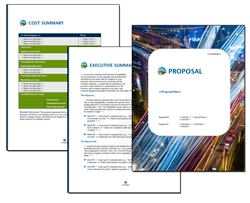
How to Write a Civil Engineering Proposal: Best Practices
Do you need help writing a proposal for a civil engineering project? This guide will walk you through each step, from defining the project scope to creating a persuasive summary. You'll have a blueprint for developing proposals that win projects.
Key Takeaways
- Civil engineering proposals are essential for securing projects and demonstrating expertise, and they can also serve as a gateway to increased business opportunities.
- Key components of a persuasive proposal include an engaging executive summary, a clear project scope definition, accurate cost estimation, and a detailed timeline.
- Collaboration with marketing teams, organizational checklists, and proposal software will enhance proposal quality and efficiency and increase the success rate.
- The conclusion of a proposal should summarize the key points and include contact information to reinforce the proposal's strengths and facilitate follow-up with a call to action.
Types of Civil Engineering Projects

There are many types of civil engineering projects for which proposals must be written. Some examples are:
- Highway and Roadway Design and Construction
- Bridge Design and Construction
- Water Supply and Distribution Systems
- Wastewater Treatment Plants
- Stormwater Management Systems
- Dams and Reservoirs
- Railway Systems and Infrastructure
- Airport Design and Construction
- Urban Development and Infrastructure Planning
- Geotechnical Engineering and Soil Stabilization
- Structural Engineering for Buildings and Towers
- Environmental Impact Assessments
- Flood Control Systems
- Seismic Retrofitting of Structures
- Pipeline Engineering for Oil, Gas, and Water
- Land Reclamation and Coastal Engineering
- Sustainable and Green Building Projects
- Mass Transit System Design
- Hydroelectric Power Plant Design
- Renewable Energy Infrastructure
Importance of Civil Engineering Proposals

Civil engineering proposals are a gateway to securing work in a highly competitive environment. They serve as a comprehensive plan for bidding on civil engineering projects, outlining its scope, methodology, and estimated costs. Think of them as the blueprint that showcases your civil engineering teams' capabilities and vision, convincing potential clients that you are the best choice for their project.
Many civil engineering proposals are written as responses to government RFPs. These proposals must include the information requested in the RFP and can be long and complex. Proposal writing software, such as Proposal Kit, is designed to assemble complex RFP responses for engineering and construction projects.
A well-written civil engineering proposal does more than outline the basics; it significantly enhances the likelihood of securing more business and contributes to revenue growth. These proposals allow potential clients to assess the feasibility and efficiency of your team, showcasing your expertise and past accomplishments.
These proposals also help civil engineers outline project scope and costs, ensuring all stakeholders understand what to expect. In a competitive market, having a comprehensive project proposal can be the deciding factor between winning and losing a project. Understanding the importance of these proposals is the first step towards mastering the proposal process.
Components of a Civil Engineering Proposal
Every successful civil engineering proposal is built on a few key components that ensure it is comprehensive and persuasive. These components include:
- An executive summary
- Project scope definition
- Cost estimation
- Timeline and milestones
- Compliance with requirements
- Persuasive content
- Capabilities and qualifications
Each element is essential in creating a proposal that stands out and communicates your vision and capabilities.
Preliminary work, such as conducting research, establishes a solid foundation for your proposal. A structured approach aids in clarity and comprehension for the reader, ensuring that all necessary elements are included and nothing is overlooked.
Considering this, let's break down each component, starting with the executive summary.
Executive Summary

The executive summary is your proposal's first impression, and capturing the reader's interest right from the beginning is crucial. This introduction section highlights the project's relevance and unique value proposition. The hook keeps potential clients engaged and eager to learn about your proposed project. This may be the only page a high-level executive reads before passing the proposal off to their staff to pick apart the details.
Different parts of a complex project proposal must be written to appeal to various stakeholders, from high-level executives to accountants and technical staff.
It is crucial to capture the reader's interest from the beginning. The executive summary should be concise yet powerful, providing a snapshot of the project's objectives, scope, and benefits. Think of it as the elevator pitch for your proposal - it should be compelling enough to make the reader want to look further into the detailed plan.
Articulating the project's unique value proposition is critical to differentiating it from competitors. This means clearly stating what sets your project apart and how it will deliver superior results. Doing so can create a solid initial impact that resonates with the reader and sets the stage for the rest of the proposal.
Project Scope Definition
Defining the project's scope is essential for setting clear expectations among all stakeholders. This involves specifying what the project will accomplish and what it will not. It's about drawing boundaries and communicating intentions effectively for successful project execution.
A detailed project scope helps communicate the project's scope, project objectives, requirements, deliverables, and strategies among all stakeholders. This comprehensive approach ensures that everyone involved understands their roles and responsibilities, reducing the risk of misunderstandings and delays.
Conducting thorough site investigations and considering environmental impacts are critical steps in project planning. These measures help prevent unforeseen challenges and ensure the project is feasible. By clearly communicating objectives, benefits, timelines, potential risks, and mitigation strategies, you can align stakeholder expectations and pave the way for a successful project.
Budget Estimation
Budgeting is essential to any civil engineering proposal as it outlines the financial plan and justifies the costs. This section demonstrates the project's feasibility and ensures transparency, which is vital for gaining client trust. Costs to include can be categorized as labor costs for each worker, materials, equipment, permits, and other expenses.
Accurate cost estimation is vital for creating a proposal. Using resources such as historical data can be beneficial. Additionally, industry benchmarks help ensure that cost estimates are realistic. A total cost figure ensures clarity and transparency, assisting potential clients to grasp the project's full financial scope.
Timeline and Milestones

A detailed timeline is indispensable for illustrating the project phases, milestones, and overall schedule. This helps set realistic expectations and ensures efficient project management. The proposal should highlight critical milestones and their significance to the project's timeline.
Tools like Gantt charts can visualize project timelines, aiding in progress tracking and deadline management. Communicating any deadline changes promptly to all stakeholders helps avoid misunderstandings and delays.
Compliance with Requirements
Before proceeding with a proposal, ensuring compliance with all project requirements is crucial. This ensures alignment with client expectations and specifications, vital for the project's success. Integrating environmental considerations and sustainable practices is essential to avoid negative impacts.
Additionally, choosing suitable materials and maintaining high-quality control standards are necessary to prevent premature deterioration and safety hazards. Ensuring compliance with all requirements can avoid costly mistakes and enhance the project's quality and safety.
Creating a Persuasive Proposal
A persuasive proposal goes beyond technical details; it's about selling your project and your team's capabilities. Highlighting past accomplishments can reinforce clients' trust in your ability to deliver desired outcomes. A winning proposal should clearly articulate project goals, benefits, and challenges, using past successes to build client trust.
Understanding client goals and concerns guides the proposal's emphasis and narrative. Avoid making assumptions about client interests; tailor your proposal to their needs and priorities. This approach helps create a proposal that resonates with the client and stands out from the competition.
Tips for Writing Winning Civil Engineering Proposals
Creating a successful civil engineering proposal requires a balance of technical knowledge and sales acumen. Keeping proposals concise allows clients to access critical information efficiently, improving memory retention. Use clear and focused language, avoiding overcomplication.
Including visual elements in proposals can help communicate designs clearly and save client reading time, reflecting your effort and attention to detail. Highlighting key takeaways for clients is a crucial strategy for creating a competitive proposal. Always review the evaluation criteria in RFPs to understand what matters most for the specific assignment.
Add a Compliance Matrix page so the reader can cross reference essential details from the RFP within the proposal.
Collaborate with Marketing Teams

Collaboration between engineers and marketing teams ensures proposals are technically sound and appealing to a broader audience. Marketers can help create a narrative highlighting your proposed project's unique strengths and benefits, making it more attractive to potential clients.
This collaboration enables the project team to meet both technical and client expectations. This collaboration can be a game-changer, transforming a good proposal into a great one that stands out and secures the project.
Select Qualified Team Members
Highlighting your team's qualifications and roles enhances the proposal's credibility and assures clients of your team's capability. Highlighting team members' expertise and certifications can increase your proposal's trustworthiness and attract client interest.
Digital Asset Management tools can significantly streamline the process of creating tailored resumes for team members, allowing for quick updates and customizations. These tools improve efficiency in creating optimal RFP resumes, ensuring that the qualifications section of your proposal is always up-to-date and relevant.
Use Checklists
Using checklists helps ensure that all necessary components of the proposal are thoroughly addressed and meet RFP specifications.
Checklists also help organize time and content based on evaluation criteria's weighting, allowing you to manage proposal efforts effectively. Conducting research and double-checking every detail helps avoid mistakes and increases the chances of submitting a winning proposal.
Tools and Software for Proposal Writing

Using Proposal Kit software in your proposal writing process can significantly improve efficiency and effectiveness. The software can streamline the proposal process, ensuring every aspect is polished and professional.
Proposal Kit's templates and software are among the best solutions for writing civil engineering proposals. These tools provide an organized approach to the proposal process, enhancing teamwork and overall proposal quality.
Proposal Kit Templates
Proposal Kit includes templates tailored to different types of civil engineering projects as starting points that can be tailored to specific RFP requirements.
Proposal Kit can assemble custom engineering and construction proposals from its extensive library of thousands of proposal topics to match any RFP requirements. The software also includes automated databases for building cost pages and schedules.
Proposal Kit also includes branding features for customization to match the document's look to your firm's identity. Overall, Proposal Kit's template and software products are among the best solutions for writing civil engineering proposals.
Here are some related samples included in every downloadable Proposal Pack
The AI Writer generates a first draft of these templates - customized to your company, client, and project - in just minutes, giving you a head start on editing. Get any Proposal Pack or Proposal Kit Professional, and all of these samples, and the AI Writer are included.
Here are some related downloadable templates
The AI Writer generates a first draft of these templates - customized to your company, client, and project - in just minutes, giving you a head start on editing. Get any Proposal Pack or Proposal Kit Professional, and all of these templates and the AI Writer are included.
Common Mistakes to Avoid

Avoiding mistakes in civil engineering proposals can significantly increase the chances of success. A common mistake is submitting a proposal after the deadline, which disqualifies it from consideration. Creating a time buffer for digital submissions helps account for internet delivery issues.
The Results section of a proposal should clearly state the results to manage client expectations. Expected outcomes from a proposal include design, construction, and a report.
Leaving out essential information required in an RFP can result in disqualification. Add a Compliance Matrix chapter to your proposals to cross-reference all critical RFP requirements to the ones addressed in the proposal.
Avoiding these pitfalls can enhance the quality and success rate of your proposals.
Summary
Writing a civil engineering proposal involves understanding the requirements, incorporating key components, creating a persuasive narrative, and avoiding common mistakes. Proposal Kit software can streamline the process, ensuring your proposal development is efficient and effective.
Following the guidelines and tips in this blog post can improve your proposal writing skills and increase your chances of securing more projects.
 Proposal Kit Professional provides the most content, including legal contracts and a free design theme pack. Plus, advanced software features include custom branding and customizable quoting databases.
Proposal Kit Professional provides the most content, including legal contracts and a free design theme pack. Plus, advanced software features include custom branding and customizable quoting databases. Proposal Pack for Any Business covers this type of proposal and includes samples. There are also some commonly used specialty design themes available:
Proposal Pack for Any Business covers this type of proposal and includes samples. There are also some commonly used specialty design themes available:Frequently Asked Questions
What is the most critical part of a civil engineering proposal?
The executive summary is the most critical part of a civil engineering proposal. It engages the reader and showcases the project's unique value.
How can I ensure my proposal meets all RFP requirements?
Create a checklist to systematically address each component to ensure your proposal meets all RFP requirements. This organized approach will boost your confidence and increase your chances of success.
Why is it essential to include a detailed budget in my proposal?
Including a detailed budget estimation is crucial because it outlines your financial plan, justifies costs, and proves the project's feasibility, building trust with potential clients.
How can collaboration with marketing teams improve my proposal?
By collaborating with marketing teams, your proposal can become technically strong and more appealing, increasing its chances of resonating with potential clients. This teamwork enhances creativity and ensures your message stands out.
What tools can help streamline the proposal writing process?
Proposal Kit templates and software tools can significantly enhance your proposal writing efficiency, helping you create polished and professional submissions effortlessly. Embrace these tools to raise your proposals to the next level.



 Cart
Cart
 Are you just looking for a template, sample, or software for your civil engineering proposals? Click these links to skip down the page and get right to it.
Are you just looking for a template, sample, or software for your civil engineering proposals? Click these links to skip down the page and get right to it.










 Facebook
Facebook YouTube
YouTube Bluesky
Bluesky Search Site
Search Site